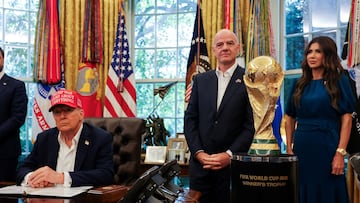How the United States could host another FIFA World Cup sooner than expected
With FIFA’s rotation system favoring North America and Oceania, the door may open for another World Cup on US soil in the not too distant future.

Nine months remain until the 23rd edition of the FIFA World Cup – the largest in history. Forty-eight teams, 104 matches, three countries, and 16 host cities will come together for a historic, innovative, tri-continental tournament. And it’s possible the United States could once again host the world’s biggest sporting event sooner than anyone imagined – with just 12 years in between.
How FIFA’s rotation could favor the US
If FIFA maintains its regional rotation model, only Oceania (OFC) and Concacaf (North America, Central America and the Caribbean) would be eligible to host in 2038. That’s because the 2030 World Cup will be shared by three confederations – UEFA (Portugal and Spain), CAF (Morocco), and Conmebol (Paraguay, Uruguay and Argentina, which will each stage one of the three opening matches to commemorate the centenary of the tournament). The 2034 edition is already set for the AFC (Asia), through Saudi Arabia’s bid.

Therefore, the 2038 World Cup could be Concacaf’s turn again, opening the door for a new US bid. Although the rotation policy is no longer officially enshrined in FIFA rules – having been “discontinued” after South Africa hosted in 2010 – the federation continues to apply it in practice. Russia hosted in 2018, and 12 years later the tournament will return to Europe, suggesting an unwritten rule of skipping at least two editions before the same region can host again.
By combining three confederations for 2030, FIFA effectively benefits Concacaf despite the short gap since 2026. Meanwhile, Conmebol – with only three games in 2030 – would not be eligible again until 2042.
A Pacific partnership: United States and New Zealand?
The Athletic first floated the idea after FIFA’s most recent Congress, held in May 2025 in Asunción, Paraguay, home to Conmebol’s headquarters. Preliminary scenarios point toward an OFC–Concacaf alliance. Since Oceania lacks the infrastructure to host a full-scale World Cup, except for what New Zealand could offer, FIFA might repeat a structure similar to 2030 – a World Cup spanning an ocean.
The concept would pair New Zealand and the United States, separated by almost 6,000 miles, connected by a Pacific corridor to shorten travel distances. The plan envisions possible venues in Fiji and Hawaii. Given the expanded 104-match format, the idea might just make logistical sense. Both nations have proven hosting records – New Zealand with the 2015 Under-20 World Cup and the 2023 Women’s World Cup (alongside Australia), and the US with decades of major-event experience.
Other possibilities on the table
Alternatives include the US hosting solo, as it did in 1994, or repeating the tri-nation format of 2026. Concacaf could also expand participation, turning the event into a regional tournament beyond the trio of Mexico, the US, and Canada.
Still, all of this remains highly speculative. The proposals are far from finalized – there are 13 years to go, and FIFA has yet to publish the terms or timeline for the bidding process.
Related stories
Get your game on! Whether you’re into NFL touchdowns, NBA buzzer-beaters, world-class soccer goals, or MLB home runs, our app has it all.
Dive into live coverage, expert insights, breaking news, exclusive videos, and more – plus, stay updated on the latest in current affairs and entertainment. Download now for all-access coverage, right at your fingertips – anytime, anywhere.
Complete your personal details to comment